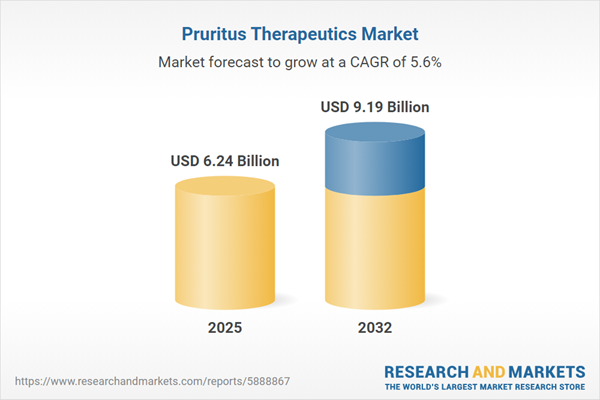Speak directly to the analyst to clarify any post sales queries you may have.
The pruritus therapeutics market is evolving rapidly, responding to the increasing need for advanced, patient-centered treatments. Senior decision-makers face a swiftly transforming environment driven by scientific progress, regulatory change, and shifting clinical priorities.
Market Snapshot of Pruritus Therapeutics
The pruritus therapeutics market grew from USD 5.93 billion in 2024 to USD 6.24 billion in 2025. It is projected to achieve a CAGR of 5.61%, reaching USD 9.19 billion by 2032.
Comprehensive Scope & Market Segmentation
This report examines the entire landscape of pruritus therapeutics and offers in-depth segmentation by therapy, administration method, indication, patient demographics, distribution, end user, geography, and company activity. The focus is on both current and emerging solutions, regional disparities, and pivotal stakeholders.
- Therapies: Antihistamines, biologics, calcineurin inhibitors, corticosteroids, immunosuppressants
- Routes of Administration: Injectable, oral, topical
- Disease Indications: Allergic contact dermatitis, atopic dermatitis, cutaneous T-cell lymphoma, urticaria
- Patient Demographics: Adult, geriatric, pediatric
- Distribution Channels: Hospital, online, retail pharmacies
- End Users: Clinics, dermatology centers, homecare, hospitals
- Regional Analysis: Americas (North America, Latin America), Europe, Middle East, Africa, Asia-Pacific
- Companies Covered: More than 25 leading global and regional manufacturers and developers including AbbVie Inc., Bayer AG, Pfizer Inc., Sanofi S.A., and others
Technology and Regional Trends
Cutting-edge biologics, advanced delivery systems, and digital health tools are prompting new models of care and expanding access. Regional differences in regulatory policy, reimbursement, and public-private partnerships shape the adoption pace and opportunities across territories.
Key Takeaways for Strategic Decision-Makers
- The sector is shifting from symptom management to patient-focused, mechanistic therapies, reflecting greater clinical sophistication and the push for improved life quality.
- Collaboration among academia, industry, and research organizations is bridging laboratory discovery with commercial implementation, fostering faster uptake of emerging treatments.
- Digital health platforms are enabling robust patient data capture and facilitating evidence-based, tailored interventions in both established and high-growth markets.
- Segmentation by disease indication and demographics supports differentiated strategies, helping businesses align portfolios with distinct clinical needs and regulatory demands.
- Operating models now prioritize agile supply chains, diversified sourcing, and increased scenario planning to reduce volatility connected with changing global trade policies.
- Market leadership is increasingly defined by the ability to efficiently scale new products globally, supported by strategic partnerships, licensing, and adaptive reimbursement models.
Tariff Impact: Navigating Evolving Trade Dynamics
The 2025 United States tariff revisions have introduced new pressures on the pruritus therapeutics supply chain, impacting everything from ingredient sourcing to logistics. Companies are responding through regional manufacturing, contract diversification, and strengthened risk management. Healthcare providers and payers monitor these changes closely, adjusting procurement strategies as necessary to safeguard patient access and financial stability.
Research Methodology & Data Sources
This report uses a rigorous, multi-source methodology combining expert interviews, peer-reviewed literature, regulatory filings, and market data. Analytical approaches include SWOT analysis, scenario planning, and real-world data review, validated through expert workshops and quality controls.
Why This Pruritus Therapeutics Market Report Matters
- Enables executives to benchmark growth and innovation strategies against a robust analytical framework that includes both established and emerging therapeutic modalities.
- Delivers actionable insight for aligning R&D priorities, navigating regulatory hurdles, and optimizing commercial strategy in diverse markets.
- Supports procurement leaders and financial strategists in managing tariff risks and evolving global supply chain complexities.
Conclusion
The pruritus therapeutics market is characterized by significant scientific, clinical, and commercial momentum. Stakeholders who prioritize patient-centric innovation and resilient business models are well-positioned to secure long-term advantage as the landscape continues to advance.
Additional Product Information:
- Purchase of this report includes 1 year online access with quarterly updates.
- This report can be updated on request. Please contact our Customer Experience team using the Ask a Question widget on our website.
Table of Contents
3. Executive Summary
4. Market Overview
7. Cumulative Impact of Artificial Intelligence 2025
Companies Mentioned
The companies profiled in this Pruritus Therapeutics market report include:- AbbVie Inc.
- Asana BioSciences, LLC
- Astellas Pharma Inc.
- Avior Bio Inc.
- Bausch Health Companies Inc.
- Bayer AG
- Cara Therapeutics Inc.
- Eli Lilly and Company
- EPI Health LLC by Novan, Inc.
- Escient Pharmaceuticals by Incyte Corporation
- Evelo Biosciences, Inc.
- Galderma S.A.
- GlaxoSmithKline plc
- LEO Pharma A/S
- Mallinckrodt plc
- MC2 Therapeutics A/S
- Mirum Pharmaceuticals, Inc.
- NeRRe Therapeutics Ltd
- Novartis AG
- Pfizer Inc.
- Regeneron Pharmaceuticals, Inc.
- Sanofi S.A.
- Teva Pharmaceutical Industries Ltd.
- Toray Industries, Inc.
- Trevi Therapeutics, Inc
- Vanda Pharmaceuticals Inc.
- Viatris Inc.
Table Information
| Report Attribute | Details |
|---|---|
| No. of Pages | 195 |
| Published | November 2025 |
| Forecast Period | 2025 - 2032 |
| Estimated Market Value ( USD | $ 6.24 Billion |
| Forecasted Market Value ( USD | $ 9.19 Billion |
| Compound Annual Growth Rate | 5.6% |
| Regions Covered | Global |
| No. of Companies Mentioned | 28 |









